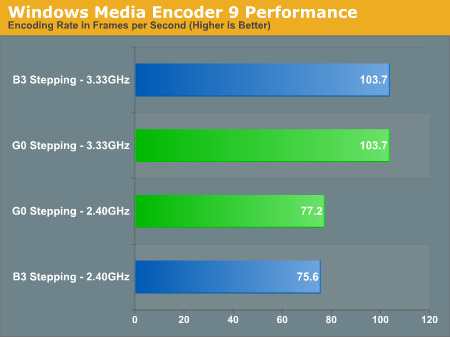Intel Core 2 Q6600 G0 Stepping: Cheap Quad Core Just Got Better
by Anand Lal Shimpi on August 16, 2007 11:53 AM EST- Posted in
- CPUs
Performance
We know the new stepping uses less power than its predecessor, and overclocks a little better, but do any of the errata fixes result in a performance increase? To find out we ran two benchmarks: our Windows Media Encoder 9 test and our Cinebench 9.5 benchmark. We ran the tests at both stock and overclocked speeds, the results are below:

There are very slight differences in performance but nothing that falls out of the range of normal variation between tests.

This sort of insignificant performance difference between steppings is to be expected, no surprises here.
Final Words
Power consumption of the new G0 cores is not only better than their predecessors, but it seems to scale better with clock speed. As we overclocked our Q6600s total system power consumption increased at a slightly lower rate with the new G0 stepping than with the previous B3 cores. The power savings aren't tremendous, we're talking on the order of 3 - 6% depending on clock speed, but it is a measurable improvement.
The impact on overclocking is a little less clear, at least with the quad-core Q6600. We were able to reach a higher maximum overclock with the SLACR stepping Q6600, but our highest stable overclock was not that much more than our original B3 stepping. If we look at percentages, our G0 part managed a 3 - 6% better overclock, putting overclocking potential in line with the power savings we noted. It's not a tremendously better overclocker but we suspect that on a whole it will yield tangible benefits.
There's no doubt that the new G0 stepping cores represent the latest improvements in the Core 2 lineup, but it's worthwhile to keep expectations in line with reality. If you're looking for a huge change in power consumption/overclocking headroom, you may have to wait for Intel's 45nm Penryn cores.










34 Comments
View All Comments
strikeback03 - Friday, August 17, 2007 - link
...that Newegg shipped me a pair of the B3 stepping ones in the box I opened this morning.Does anyone actually sell these for $266? Cheapest I found seemed to be around $285.
Roy2001 - Friday, August 17, 2007 - link
$266 is price for 1000 units. Since demand is high and there is no competition, retailers would price it higher. Remember how much egg wanted when they restock it? From $299 to $379.ruusnak - Friday, August 17, 2007 - link
Did you measure temperature differences under load? Even when the new stepping draws more power, the Intel spec sheet's temp curves are quite different... does G0 run hotter or cooler in practice?ruusnak - Friday, August 17, 2007 - link
I meant "even if the new stepping draws less power" of course...jay401 - Thursday, August 16, 2007 - link
What's this Intel Resource Center that's now a link at the bottom of the conclusion page next to "Home"? I don't see an AMD Resource Center at the bottom of the concluding page of AMD articles.vijay333 - Thursday, August 16, 2007 - link
Intel ponied up the cash : "This site is presented by Intel" (right on top), while AMD chose not to for some reason...mostlyprudent - Friday, August 17, 2007 - link
Or, it could have something to do with the fact that it's an article about a new stepping of an INTEL chip. This site is so pro Intel that they spent a year or more recommending Athlon X2s as the chips to buy. Must have been a conspiracy so that when the Core 2 was released they could show their true colors.vijay333 - Thursday, August 16, 2007 - link
probably deprecated due to lack of activity...jto168 - Thursday, August 16, 2007 - link
Anand,Is it possible for you to state which Batch # the B3 stepping came from?
I have found that many users with earlier Batches of B3 have found it difficult to overclock it successfully as the thermal throttling usually backs the multiplier down.
brentpresley - Thursday, August 16, 2007 - link
For the record - C2D never shipped on the B1 stepping (it was only available in ES chips). The first OEM and Retail silicon was the B2 stepping.